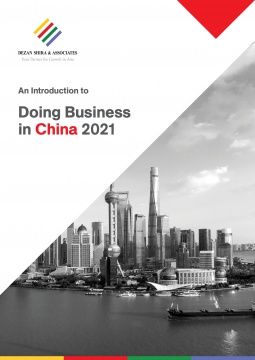By Bob Savic, Advisor to Dezan Shira & Associates
The world economy experienced a precipitous -42% decline in global foreign direct investment (FDI), last year, according to UNCTAD. This setback particularly impacted developed economies with a yearly slide of -68%, being the steepest on record, and leaving FDI inflows at a quarter century low of US$229 billion in 2020. Asia’s overall FDI declines were comparatively less pronounced, while in China’s case, FDI inflows were not only positive, but actually grew faster than in 2019. Suffice it to say, Asia is currently leading the global economy with FDI inflows either picking up, at the beginning of 2021, or demonstrating convincing signs of a significant rise from last year’s negative growth patterns.
Developing Asia sees robust FDI inflows in 2019
According to the 2020 UNCTAD World Investment Report, which covered FDI inflows into various global regions over 2019, developing Asia’s FDI inflows for that year dropped by -5%, over the previous year, to US$474 billion. This negative outcome was almost wholly attributable to the precipitous decline of FDI inflows into Hong Kong, which fell by -34%, as investor confidence in the financial entrepot was shaken by the political turmoil there in 2019. The other four of the top five developing Asian economies, including China, Singapore, India and Indonesia each saw notable increases in FDI inflows. In particular, the latter three evidenced double digit rises of 15.5%, 19.9% and 18.9% respectively, while China’s inward direct investment gained by a positive, albeit relatively lacklustre 2.1%.
China’s 2020 FDI inflows jump post initial Covid-19 outbreak
China’s FDI inflows saw one of Asia’s fastest rates of expansion in January 2021, rising by a yearly 4.6% and totalling US$13.5 billion for the month. According to China’s Ministry of Commerce, the services sector, which is being nurtured by the Chinese government into becoming the main engine of domestic demand led growth in line with an ongoing shift from investment into consumption, benefited from the strongest sectoral FDI rise of 11% per annum amounting to US$10.1 billion.
China’s strong FDI showing, for January 2021, comes on top of a record year for FDI inflows in 2020. This reached an annual total of US$145 billion – eclipsing FDI inflows into the US in the process. The annual FDI increase of 6.2% was essentially achieved over nine consecutive months of positive FDI inflows from April to December, following the first quarter of FDI decline. Much as in January 2021, the services industry was 2020 largest recipient of FDI; rising by a yearly 13.9% to US$120 billion and accounting for a record portion of overall FDI. This statistic alone demonstrates the rising appeal of China’s steadily expanding giant services sector for international investors. Even more noteworthy has been FDI flows into China’s IT services, which leapt by over 28%, in 2020.
The countries accounting for the highest growth rates of FDI inflows into China were the Netherlands and Britain, expanding by 48% and 31%, respectively. While the Netherlands is typically a holding company jurisdiction from which companies based elsewhere route their investments into China, the UK does not normally play this role given its complex outbound tax rules. This makes the UK’s substantial rise in FDI, during a year where the British and Chinese governments ratcheted up the geopolitical tensions over Hong Kong and other matters, particularly notable and maybe augurs well for future bilateral relations.
ASEAN’s FDI inflows down, but not out
By contrast to China, the ten-member Association of Southeast Asian Nations (ASEAN) regional bloc saw a precipitous -31% decline in FDI inflows, albeit totalling a not unimpressive US$107 billion for 2020. According to UNCTAD’s Investment Trends Monitor, for 2020, ASEAN also registered growth of US$70 billion in greenfield investments despite this figure being a decline of -14% on the previous year. Even so, it was the biggest such FDI inflow of any developing world region, while the contraction in the number of ASEAN’s greenfield projects, by foreign investors, was also less than other developing economy groupings.
The levels of FDI inflows into ASEAN varied from country to country. Vietnam was the relative top performer, of the region’s larger economies, even though its 2020 FDI inflows dropped by 10%, from 2019, to around US$20 billion for the year. The hit to investment was especially negative for investment commitments which tumbled by around a quarter from the previous year to US$28.5 billion, according to Vietnam’s Ministry of Planning and Investments.
In spite of these ominous signs, January 2021 saw a yearly rise of 4.1%, in January 2021, an increase for that month not far removed China’s inward investment expansion over the same period. Of the US$1.5 billion in FDI inflows, the lion’s share of about 75% was channelled into manufacturing and processing industries. This was followed by investment into the real estate sector accounting for nearly 9% of the total. The top investment sources for January 2021 were Singapore, China and Hong Kong.
By contrast to Singapore’s abundant corporate outbound investment, into the region, in 2020, its inward investment flows measured less well; contributing to a record-level economic contraction of 5.4% in that year. According to UNCTAD’s Investment Trends Monitor report covering 2020, Singapore’s FDI inflows shrunk by -37% in 2020, levelling off at US$58 billion. Although the city-state’s inward investment drop exceeded the ASEAN average of -31%, amid a decline that was a third less than its 2009 global financial crisis level low, it still held pole position as ASEAN’s largest recipient of FDI inflows.
As developing Asia’s fifth largest recipient of FDI, Indonesia’s Covid-ravaged economy suffered an investment downturn of -24% over 2020, according to Indonesia’s Investment Coordinating Board, with total investments levelling out at US$18 billion. Most of the FDI decline was attributable to the first half of the year with the country’s widespread lockdowns. Since then, FDI inflows have been gaining momentum, rising by a yearly 1.1%, in Q3 2020, followed by a stronger 5.5% rise in Q4 2020. This trend is signalling sustainably higher FDI inflows into 2021. While China and Singapore were the principal FDI sources, the main sectors attracting FDI were telecoms, transportation, warehousing and utilities.
According to the 2020 UNCTAD report, ASEAN’s other major economies, encountered even more severe declines in FDI inflows during that year. It reported that Thailand and Malaysia were especially negatively impacted. However, to shine a different light on statistical methodologies, while Malaysia’s Department of Statistics accepts UNCTAD’s “net FDI inflow” computation as a standard balance of payments driven measure, it argues that by taking account of an alternative measure, in the form of “gross FDI inflows”, then for the first nine months of 2020, investments into Malaysia were up by 5.8% on the previous year, totalling US$26.8 billion in that period. Nevertheless, in utilising the standard UNCTAD measure, Malaysia’s FDI inflow rose to US$1.5 billion in Q4 2020, reversing an outflow in the previous quarter, and pointing to the country’s re-emergence as a major investment destination following the lifting of its pandemic restrictions. The main investments, into Malaysia, over the quarter, were from neighbouring Thailand, Singapore and Japan with the bulk of funds channelled into manufacturing, finance and retail trading sectors.
One ASEAN country which has reportedly been the exception to the regional trend decline in FDI inflows has been the Philippines. Although the country is normally one of the region’s smaller recipients of FDI inflows, nevertheless inward direct investment rose by a yearly 29% to US$6.4 billion in 2020. This positive result was mainly a consequence of surging net equity capital investments which were up by 48.6% in the first 11 months of 2020. These funds were mainly channelled into manufacturing, banking and insurance, and property with the sources of investments originating from Japan, Singapore, the Netherlands and the US.
India – Asia’s new FDI star performer
India’s economy seems set on entering a new era of high and sustained FDI inflow growth. In the face of the global pandemic, which has also seriously impacted India’s population, the country’s FDI inflows proceeded to hit record highs in 2020. According to India’s Ministry of Commerce and Industry, from April to November, constituting the first eight months of the financial year, FDI inflows rose by US$58.4 billion; setting a record over this period, and 22% above the same eight months in 2019. Of that amount, US$43.8 billion was invested as equity capital, up by an annual 37% rise which was the highest on record. The strong FDI data was topped off by November 2020, as the most recent reported month, with investment inflows surging by 81% annually to reach US$10.2 billion versus the previous year’s same period.
The bulk of investments went mainly into two sectors. These included US$7.6 billion in services being specifically oriented towards banking, finance, insurance, R&D, testing and analysis, and outsourcing. Up to US$7.4 billion was channelled into computer hardware and software. Retail and wholesale trade, telecoms, tourism and automobile production also benefited from strong FDI inflows.
India’s largest investment source was Singapore with US$8.3 billion, although the city-state is often a conduit for investments originating mainly from China, nowadays, but also for companies based in North America and Europe. The second largest source was the United States which overtook Mauritius, another investment conduit jurisdiction, with US investments totalling US$7.12 billion. The surge in American corporate interest, over 2020, was mainly attributable to its technology giants buying up Indian tech ventures, assisted by the friendly political ties established between former US President Trump and Indian Prime Minister Narendra Modi. Holding company jurisdictions, such as the Cayman Islands and Netherlands contributed US$2.1 billion and US$1.5 billion, respectively, while other direct major investment sources included the UK with US$1.35 billion and France’s US$1.13 billion.
Global FDI is shifting into Asia, but it’s not a uniform picture
In conclusion, Asia appears to be riding the crest of the wave in attracting global FDI inflows even as the pandemic halted much of global economic activity in 2020. Most notably, during that year, China overtook the US as the largest recipient of FDI, while both China and India posted positive FDI inflow growth, particularly driven by the attraction to foreign investors of their giant and fast expanding services sectors. In saying that, the most significant boost in FDI inflows was clearly experienced by India with surging levels of FDI growth in its financial and science-based services and IT sectors, driven in large part by US multinationals’ long term interests in competing with China’s growing global IT companies, as well as tapping into India’s potentially vast domestic market. Although ASEAN’s FDI inflows were largely negative during 2020, several of its economies appear to be back on track in attracting growing levels of FDI, boosted by a series of recently-agreed regional trade agreements, in addition to prospective ones, which connect the regional bloc to the giant growing markets of China and India.
About Us
Dezan Shira & Associates is a pan-Asia, multi-disciplinary professional services firm, providing market entry, legal, accounting, tax, HR, technology and operational advisory to international investors. Operational throughout China, ASEAN and India, our mission is to guide foreign companies through Asia’s complex regulatory environment and assist them with all aspects of establishing, maintaining, and growing their business operations in the region.
Related Reading
 An Introduction to Doing Business in China 2021
An Introduction to Doing Business in China 2021
 An Introduction to Doing Business in ASEAN 2021
An Introduction to Doing Business in ASEAN 2021
 An Introduction to Doing Business in India 2021
An Introduction to Doing Business in India 2021
Disclaimer
Any views or opinions represented in this blog are personal commentary, belong solely to the contributor and do not necessarily represent the views of Asia Briefing Limited or Dezan Shira & Associates.


